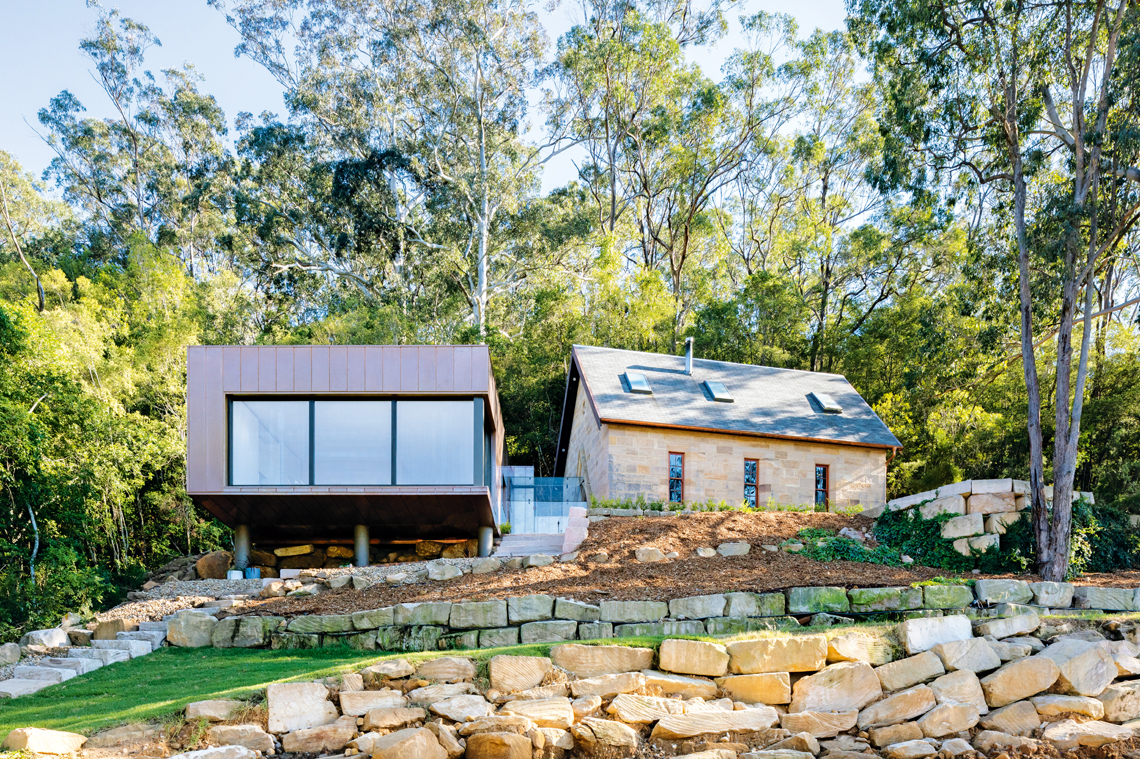Back in 2013, Simon and Lauren bought a 1.5-acre riverfront property with a derelict 60sqm sandstone chapel and cemetery. Labelled a “high-risk ruin” by the bank, and discouraged by family, the couple still found it too tempting to ignore. Over 16 months, they single-handedly transformed the abandoned chapel on the Hawkesbury River into a modern two-bedroom home. Six years and two kids later, the family had outgrown the chapel. They realised: either extend creatively or move on. Selling, however, was not an option.
“Our brief for the second project was to create a sustainable off-grid, modern family home that performs economically without compromising space, comfort, functionality, lifestyle or design. It was important to us that we create an addition that provided us all the modern comforts the church lacked (heating, space, view of the river etc) while keeping the original build the main focus,” say Simon and Lauren.

Off-Grid Living and Smart Sustainability
While renovating, town water and power weren’t available — and were far beyond Simon and Lauren’s budget. So, they installed solar panels for electricity. Simon, a trained engineer and plumber, built a smart pump and filtration system for clean drinking water from the river. Already off-grid, the new extension had to follow the same principles, so Simon explored passive housing for its excellent thermal performance and energy efficiency.
“We really wanted to create a historically sympathetic, sustainable and luxurious family home that celebrated the rich history and beauty of our little pocket of the globe,” says Lauren. “Simon also insisted on using premium materials and craftsmanship to ensure our new addition would easily last another 150 years.”

Building a Budget-Friendly Passive House
Passive housing has become popular due to the construction’s super-efficient thermal properties.
Construction materials are key to a passive house but due to budget constraints, Simon worked closely with LogikHaus, a startup looking to bring quick, cost-effective, prefabricated passive house panels to the market. The was the first project for LogikHaus — Simon and his tradie mates provided the labour while LogikHaus provided the materials. With a combination of thick insulation, triple-glazed windows and almost a kilometre of tape, the new extension stays at a comfortable temperature all year round, no matter what the weather is like outside.
“Our own aesthetic aims to be contemporary and timeless,” says Lauren. “It is important that we don’t try to replicate the original features of the church. Our design is influenced by our need to keep the old and the new easily distinguishable and not blur the lines between the historic features and the new additions … the property dictated the design in every way.”

Respecting the Chapel’s Legacy
Preservation of the chapel was always the main consideration throughout the extension design. The modern building would stand alone from the chapel, not to compete with it but to fade into the background and allow the chapel to remain the hero. But whether or not to physically link the two buildings was what kept Simon awake at night. His main concern was not damaging or interrupting the facade of the chapel.
Connecting Past and Present
Inspired by architecture that blends old and new, like the Adelaide State Library, Simon and Lauren added a glass walkway between the chapel and the modern extension. It protects the family from the weather while keeping the chapel’s original facade visible. Designed with Palmers Glass, the linkway connects past and present. Every ceiling panel is etched with the names and dates of those buried in the cemetery, honouring their memory. “The link between the two buildings generated the most heated discussions and focused problem solving, and resulted in something we are truly proud of,” say Simon and Lauren.
Now with a sibling 150 years its junior, a cantilevered, copper-clad, passive house sits lovingly beside the sandstone Hawkesbury chapel. With a three-bedroom, two-bathroom extension and views that truly capture the Hawkesbury River location, Simon and Lauren have not just one, but two dream homes. “We have a deeply spiritual connection to the property and now to the memories made building our house. Every morning, we look out over the river with gratitude for being able to call this place home and the opportunities and lifestyle it has afforded us. Best of all, with its own onsite cemetery, we never have to leave! Just roll us down the hill and add a headstone!”
















